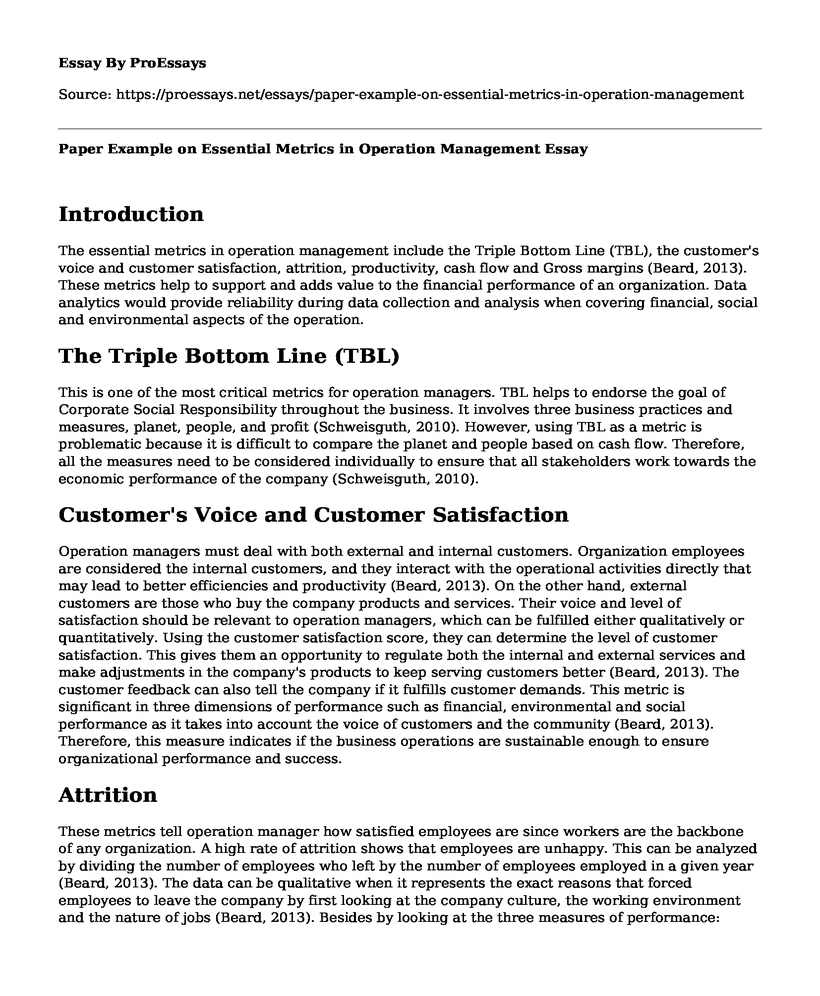Introduction
The essential metrics in operation management include the Triple Bottom Line (TBL), the customer's voice and customer satisfaction, attrition, productivity, cash flow and Gross margins (Beard, 2013). These metrics help to support and adds value to the financial performance of an organization. Data analytics would provide reliability during data collection and analysis when covering financial, social and environmental aspects of the operation.
The Triple Bottom Line (TBL)
This is one of the most critical metrics for operation managers. TBL helps to endorse the goal of Corporate Social Responsibility throughout the business. It involves three business practices and measures, planet, people, and profit (Schweisguth, 2010). However, using TBL as a metric is problematic because it is difficult to compare the planet and people based on cash flow. Therefore, all the measures need to be considered individually to ensure that all stakeholders work towards the economic performance of the company (Schweisguth, 2010).
Customer's Voice and Customer Satisfaction
Operation managers must deal with both external and internal customers. Organization employees are considered the internal customers, and they interact with the operational activities directly that may lead to better efficiencies and productivity (Beard, 2013). On the other hand, external customers are those who buy the company products and services. Their voice and level of satisfaction should be relevant to operation managers, which can be fulfilled either qualitatively or quantitatively. Using the customer satisfaction score, they can determine the level of customer satisfaction. This gives them an opportunity to regulate both the internal and external services and make adjustments in the company's products to keep serving customers better (Beard, 2013). The customer feedback can also tell the company if it fulfills customer demands. This metric is significant in three dimensions of performance such as financial, environmental and social performance as it takes into account the voice of customers and the community (Beard, 2013). Therefore, this measure indicates if the business operations are sustainable enough to ensure organizational performance and success.
Attrition
These metrics tell operation manager how satisfied employees are since workers are the backbone of any organization. A high rate of attrition shows that employees are unhappy. This can be analyzed by dividing the number of employees who left by the number of employees employed in a given year (Beard, 2013). The data can be qualitative when it represents the exact reasons that forced employees to leave the company by first looking at the company culture, the working environment and the nature of jobs (Beard, 2013). Besides by looking at the three measures of performance: financial, environmental and social, attrition touches on the social angle since employees can leave when the social aspect is unsustainable.
Productivity
This metric helps to determine the performance of the company. A company's productivity can be measured using the ROI (Beard, 2013). The qualitative data is based on the company's investment and the return it has achieved after considering all the expenses. Productivity is based on all the company's functions including marketing and sales of the organization. This measure is, therefore, critical from the financial sustainability angle since when productivity is low, the business will not be sustainable financially and operationally (Beard, 2013).
Cash Flow
One of the significant metrics in operation management is cash flow. It evaluates deflations and cash influxes (Cash Flow Indicator Ratios, 2007). The primary qualitative indicators include the returns of the company and the cash it needs to pay to its vendors and creditors. Whenever the cash flow is not positive, the company would struggle in all aspects, and it may not function efficiently and timely. Operation manager can use Days Payable Outstanding (DPO) and Days Sales Outstanding (DSO) to improve the quality of the cash flow metric (Cash Flow Indicator Ratios, 2007). Therefore, this measure is critical because, with negative cash flow, the operations of the business become unsustainable.
Margins
This metric show how healthy and productive is a company's operation. By taking into account, the company's revenues from the operation of the business and expenditure incurred during the process would indicate the performance of the company (Beard, 2013). This measure is financially sustainable because if the margins are low financially and operationally, then it has unsustainable operation management.
Conclusion
If these metrics are measured and monitored correctly, operation managers will be able to take into account all the negativities and challenges that come with business operations. The business environment is so dynamic, and it is ever evolving, they have to ensure the choice of each metrics is reviewed since what may be relevant in business operation today, may be irrelevant in future.
References
Beard, R. (2013, September 2). Customer Satisfaction Metrics: 6 metrics you need to be tracking. Retrieved August 24, 2018, from http://blog.clientheartbeat.com/customer-satisfaction-metrics-6-metrics-you-need-to-be-tracking/
Cash Flow Indicator Ratios. (2007). Retrieved August 24, 2018, from http://www.investopedia.com/university/ratios/cash-flow-indicator/
Schweisguth, M. (2010, January 26). Getting Real About Measurement: How to Size up the Triple Bottom Line. Retrieved August 24, 2018, from http://www.greenbiz.com/blog/2010/01/26/getting-real-about-measurement-how-size-triple-bottom-line
Cite this page
Paper Example on Essential Metrics in Operation Management. (2022, Jul 11). Retrieved from https://proessays.net/essays/paper-example-on-essential-metrics-in-operation-management
If you are the original author of this essay and no longer wish to have it published on the ProEssays website, please click below to request its removal:
- Product Harm Crisis
- Data Privacy Law: Comparison Between the United States and Saudi Arabia
- Paper Example on Plan-Do-Check-Act
- Reflection on the Two WorldCom Readings Paper Example
- Philosophy of Leadership Statement Essay Example
- Essay Example on Allison Elam's Idea: New MRP System or Costly Catastrophe?
- Value-Based Leadership: a Necessity for Success - Essay Sample







